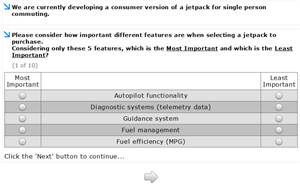You’ve identified a number of product concepts, features, or user stories. Which of these should be prioritized for a feature backlog? Which concepts are the most promising, suggesting follow-up pricing research? MaxDiff is a method for scaling a large number of items (15-20) by preference or importance.
How it works
It can be difficult for survey respondents to rank a large number of items. MaxDiff solves this issue by breaking up the larger list into a number of smaller questions. For each question, the respondent is asked to indicate the best option (most preferred, most important) and worst option (least preferred, least important). The analysis sorts the items from best to worst and scales the results so that the items sum to 100.
Unabashed Research LLC uses Sawtooth Software to design and program MaxDiff surveys.
Pros:
-
Using scales to rate importance or preference can have drawbacks. If each item is important, there might not be enough fidelity to discriminate differences in importance between items. MaxDiff avoids this issue and can detect subtle differences in importance or preference between items.
Cons:
-
A potential drawback to traditional MaxDiff is the lack of a “zero” point, that is, the ability to detect items that are considered unimportant or are not preferred. However, additional methodology can be included to detect those items that respondents would prefer not to see in a finished product.
-
Also, a note of caution when interpreting the scaled items. Strictly speaking, the common scale used to score the items is related to the probability of a respondent selecting that item on any given task. While this can safely be used as a proxy for preference or importance, it should be viewed as an approximation to the true, underlying preference scale. As an example, suppose a MaxDiff exercise has 20 numbers from 1 to 100, and respondents are simply asked to indicate which number in each subset is the maximum and which is the minimum. The resulting analysis, scaling the items so that they sum to 100, won’t necessarily match the original items on the list.
